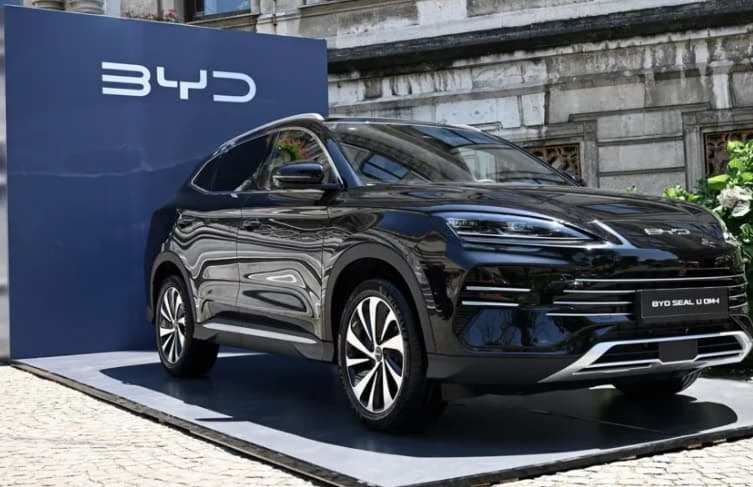1. BYD cars are hot-selling in Singapore, taking the first place in sales
As a leading domestic car brand, BYD also leads the market overseas.
According to the registration data of the Land Transport Authority (LTA) of Singapore, BYD sold a total of 3,002 cars in the first four months of this year, accounting for 20% of Singapore’s total car sales, becoming the most popular car brand in Singapore so far this year. Among competitors in the same period, Toyota and Tesla sold 2,050 and 535 cars respectively.
However, this is not the first time BYD has won the title of first. If calculated by new car sales, BYD has successfully surpassed Toyota and BMW in 2024 and became the best-selling car brand in Singapore in 2024. BYD registered 6,191 new cars that year, with a market share of 14.4%. This is also the first time that a Chinese brand has topped the Singapore car best-selling list.
It entered the market later than other brands, but took the first place in sales, which shows BYD’s strength.
In 2022, BYD officially entered the passenger car market in Singapore, and the first A-class trendy SUV ATTO 3 was launched in Singapore, which was also the first appearance of this model in ASEAN countries. Since then, with the series of models such as Seal and Dolphin, BYD has further opened up the Singapore automobile market.
In less than a year, BYD began to emerge. According to LTA statistics, in the first five months of 2023, BYD won the first place in Singapore’s electric vehicle sales, with 303 new car registrations. By the end of the year, BYD ranked fourth in the overall sales ranking, with a market share of 4.7%. This is also the first time that a Chinese auto brand has entered the top ten of the list.
At the same time, BYD Commercial Vehicles is also accelerating the expansion of its business scale. LTA public documents show that at the end of 2023, BYD signed a large order for electric buses. According to the LTA plan, it is expected to purchase 360 electric buses and put them into use one after another, of which 240 will be produced and delivered by BYD, with a contract amount of 108 million Singapore dollars (about 580 million yuan).
In addition to Singapore, BYD Thailand also performs well in the Southeast Asian market. Data shows that in 2024, the registration volume of pure electric vehicles in Thailand will exceed 70,000, of which BYD ranks first in sales and has a market share of more than one-third. In addition, Thailand is also BYD’s overseas production base. In July last year, BYD’s first overseas passenger car factory landed in Thailand and officially started production, with an annual production capacity of about 150,000 vehicles.
At present, BYD has entered many important markets such as Southeast Asia, Europe, and Australia, and its annual overseas car sales have exceeded 400,000 vehicles.
People familiar with the matter revealed that in the future, BYD still has high hopes for its overseas business, and the goal is to increase the proportion of overseas car sales to 50% by 2030, which is equivalent to replicating the scale of BYD in China overseas.
2. Domestic cars are accelerating to go overseas
In fact, BYD is just the tip of the iceberg of domestic cars going overseas. Riding on the east wind of new energy vehicles, the entire domestic automobile industry is accelerating to go overseas. Especially in recent years, domestic brands have relied on their own strength to make the global automobile market pattern undergo earth-shaking changes.
On the one hand, domestic automobile enterprises are technologically advanced, and their product advantages in the field of new energy vehicles are more prominent. This can be seen from the recent grand occasion of the Shanghai Auto Show. Not only are there more foreign faces in each exhibition hall, but also visitors from all over the world. Auto executives observe and learn, enthusiasts enthusiastically participate in the exhibition, and there are also major international mainstream media such as Reuters, Bloomberg, and Nikkei News.
On the other hand, relying on this technological advantage, the competitiveness of domestic automobiles has been greatly improved, and domestic automobile brands have been able to quickly expand overseas markets.
In 2024, SAIC’s brand MG sold more than 240,000 vehicles in Europe, a year-on-year increase of 5%, with the UK market share ranking second. Great Wall Motors exported 220,000 vehicles to Russia, accounting for about 50% of its total exports. Geely Auto has a market share of more than 20% in Malaysia with its hot-selling models such as Proton X50 and X90.
Of course, in expanding overseas territory, domestic automobiles have also encountered considerable challenges, such as tariff barriers, which requires brands to deploy multi-line businesses in production, transportation, sales, etc., and reduce regional policy risks with a global layout.
For example, automobile brands have begun to accelerate the layout of overseas production capacity. At the beginning of last year, BYD signed an agreement with the Szeged City Government of Hungary to build BYD’s first European new energy passenger car factory in Hungary. At the end of the year, Chery’s Spanish factory went into production. Before that, Chery had a total of 10 production bases overseas, mainly distributed in South America, the Middle East and Russia.
It can be said that in the past few years, domestic cars have been on the fast track to go overseas. From BYD electric buses on the streets of Southeast Asia, to the MG4 EV that young people in Europe are rushing to order, to the NIO ET7 in the garage of the local tycoons in the Middle East, domestic cars are using technology and appearance to break prejudices and become the new top stream in the global car market.
















Leave a Reply